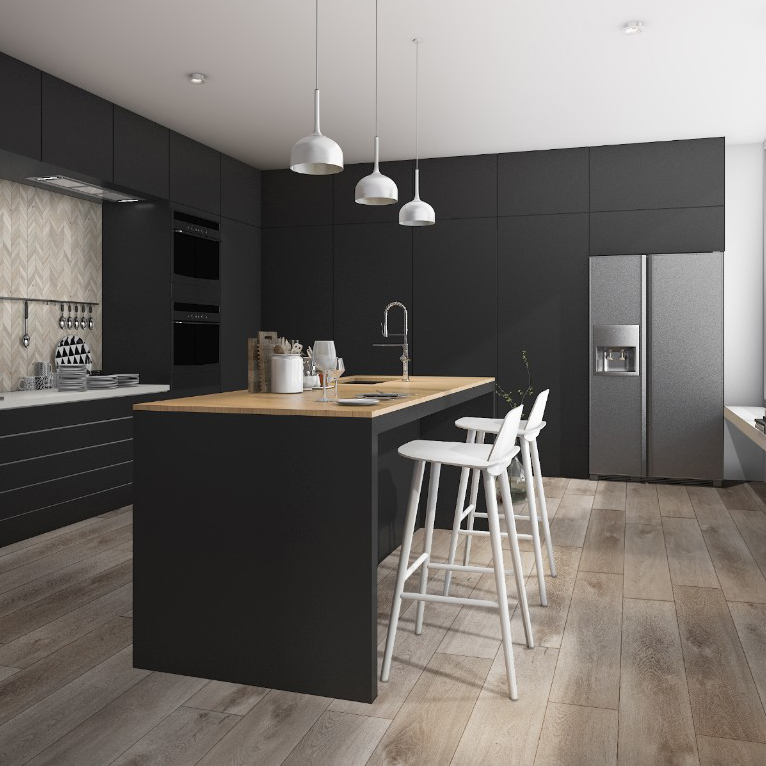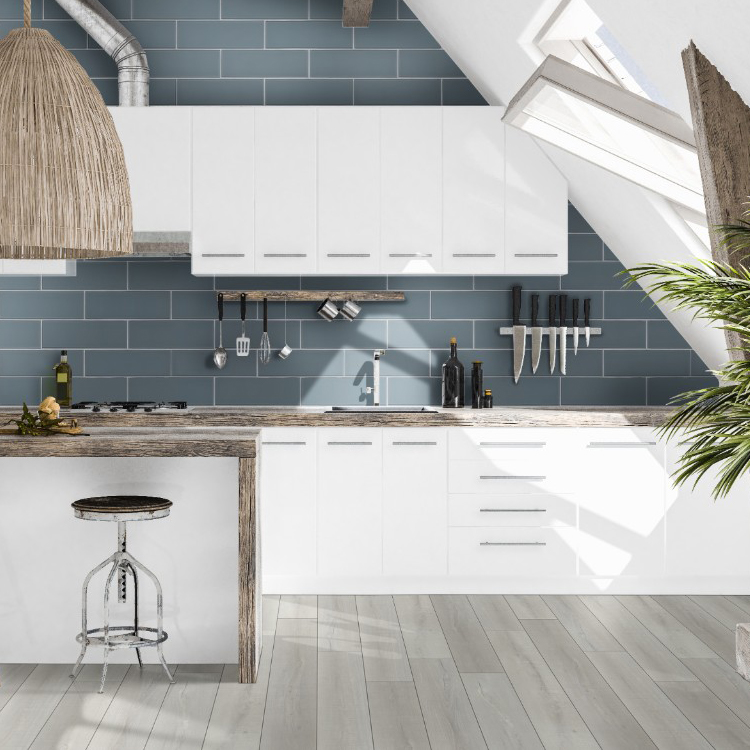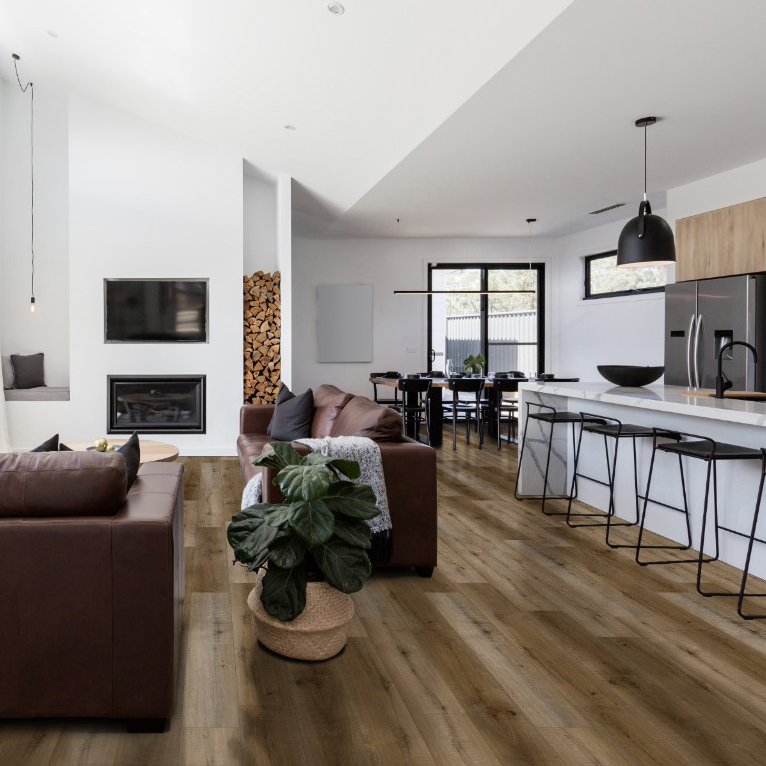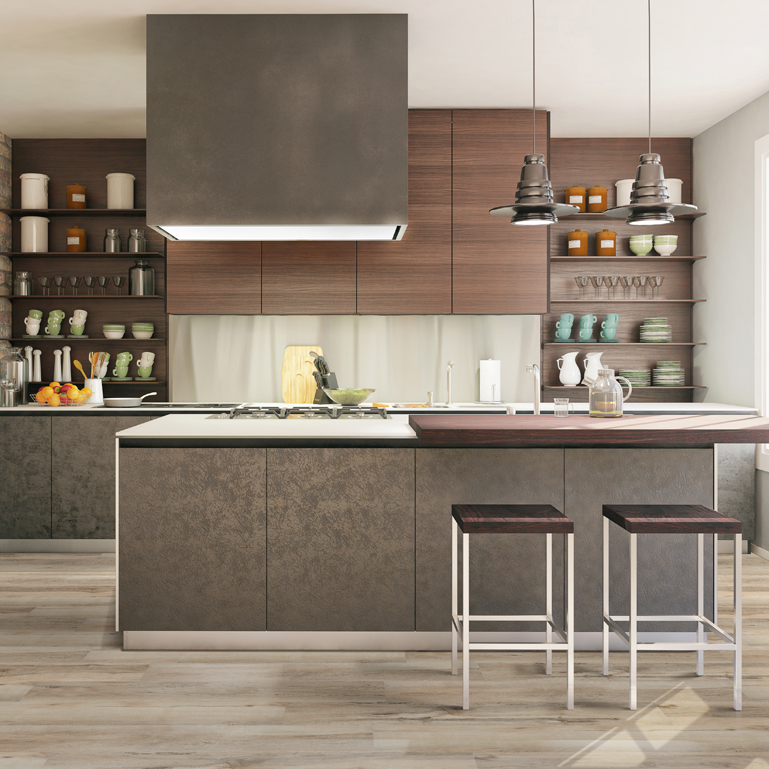The Definitive Guide To Luxury Vinyl Flooring
October 25, 2019.jpg)
One of the hottest housing products on the market is luxury vinyl flooring (LVF), and for good reason. Thanks to continuous advancements in technology, this wood look-alike features realistic styles and colors that come with something real hardwood does not offer, 100-percent waterproof or water-resistant capabilities. LVF comes in several types but we will focus on two: glue-down (flexible) or a Rigid Core click system. They both provide high-dimensional stability and durable wear layers that are designed to be kid-proof, pet-proof, and worry-proof for homeowners and business owners alike. In the case of our Rigid Core, it is even slip resistant, as measured by TCNA’s DCOF AcuTest. In this guide, we break down all the detail you need to know about this affordable flooring choice. We will also explain the differences between LVT, standard vinyl flooring, luxury vinyl flooring (LVF), and luxury vinyl plank (LVP).
How Does Luxury Vinyl Flooring Differ from Standard Vinyl Flooring?
Luxury Vinyl Flooring and Luxury Vinyl Plank are all different names for the same category, most widely recognized as LVF. LVF is available in predominately two types: Rigid Core and flexible. The most popular Rigid Core products are click-system installation products, and the most popular flexible products are glue-down system installation products. The third largest vinyl product in volume is sheet vinyl. While declining rapidly in popularity, it still is the third largest product in the resilient category. Both types of vinyl are mostly made up of similar layers that include polyvinyl chloride, which is commonly known as vinyl. The print layer, which gives the product its design, sits on top of a vinyl core. A urethane coating is added on top of a wear layer that provides protection for the print layer. A glue-down flexible product will not include a pre-attached underlayment, but Rigid Core products with a click system typically come with a cork or foam attached backing.
However, LVF is up to five times thicker than the typical 1 mm-thick sheet vinyl, and 2 1/2 times thicker than the typical flexible LVT (2mm). The wear and film layers are thicker and provide excellent durability and protection against everyday wear and tear. You can expect residential sheet vinyl floors to last up to 15 years, but with LVF, you can expect it to last 20 years or more.

One thing that its name indicates is a higher price tag for the more luxurious product. The price for LVF ranges in cost from approximately $2 per square foot up to $10 per square foot for premium materials, whereas sheet and flexible LVT are the most budget-friendly options available with costs ranging from 50 cents per square foot up to $2 per square foot.
But, the price increase typically means you’ll end up with more design options, more details, and improved durability with LVF. LVF does a much better job at mimicking the natural look of wood with its knots, grains, and textures or stone with its coloring and pattern, and the picture quality provides less artificial prints unlike regular sheet vinyl. You can learn more by watching this luxury vinyl flooring video.
How does Luxury Vinyl Plank (LVP) Flooring, Luxury Vinyl Flooring (LVF) and Luxury Vinyl Tile (LVT) Differ?
You probably have heard the terms luxury vinyl plank (LVP), luxury vinyl flooring (LVF), and luxury vinyl tile (LVT) used, and they are all practically interchangeable. LVP, LVF, and LVT all refer to the same luxury vinyl category. Manufacturers typically photograph an existing wood floor and then imprint that image onto a printed layer that sits on top of the vinyl layer. Manufacturers also photograph real natural stone, ceramic, or other materials, and the image is attached to the vinyl core. They are both available in Rigid Core and flexible products, and both are more affordable options when compared to installing real hardwood or natural stone, and as technologies have improved, it is more difficult to tell the difference between LVT and its natural counterparts.
What Are the Best Uses of Luxury Vinyl Flooring?
Whether you have a very busy household or need it for commercial use, rest assured knowing that vinyl flooring works well for high traffic areas. The thick wear layer helps protect the vinyl flooring from scratches, scuffs, stains, and dirt that may occur from daily use. Many LVF products are suitable for all indoor spaces, from the basement to the living room to the bedrooms. But, your LVF installations don’t need to stop at wet areas. That is because both the water-resistant and 100-percent waterproof flooring can be installed in kitchens, laundry rooms and most bathrooms. Everlife Rigid Core LVF also passes TCNA’s >0.42 DCOF slip resistance testing, assuring safe installations in interior rooms exposed to moisture, such as bathrooms and kitchens.

Luxury Vinyl Flooring Pros and Cons
There are many advantages to purchasing LVF. It’s one of the easiest flooring products to install, so if you’ve previously tackled DIY projects, then you should have no problem gluing down or clicking in place your new vinyl flooring. Products with a Rigid Core do not require any acclimation prior to installation, so you can purchase product and install it the same day. However, typical flexible LVF products may need 24 to 48 hours to acclimate in the room, so be sure to check with the manufacturer. You might be able to place vinyl directly on top of your current flooring, which greatly reduces demolition costs when taking out old tile, but it will need to be in good condition, flat, and the surface must be clean.
Another major benefit of LVF is that there is very little required maintenance. All you need to do for routine cleaning is to dust mop or sweep your vinyl floors. Surprisingly, you can safely wet-mop a Rigid Core LVP floor, unlike with laminate or wood that can be permanently damaged with wet-mopping. You also never need to seal, buff, wax, or re-condition your luxury vinyl floors, and it rarely requires a special cleaner. Regular cleaning is all you need to keep your vinyl looking like new for the next couple of decades.
Even though many consumers are fooled into thinking that LVT and LVP are the real thing, there are still some homebuyers who prefer the natural imperfections of wood or stone to vinyl despite its boastful benefits; while you would never want to install wood outside, you also can’t install luxury vinyl outdoors either, whereas you can with certain stone or tile.
Important Luxury Vinyl Flooring Factors
One of the most important measurements for luxury vinyl flooring is the wear layer. This most important clear layer protects the print layer from damage, and the best ones come with a polyurethane finish that’s further reinforced with mineral additives. This layer ranges from 6 mil up to 30 mil, but a typical wear layer, like a 12 mil or 20 mil, is optimal for cost purposes and also for protecting residential spaces against scratches and wear, while a commercial application requires a minimum 20 mil layer.
A newer feature you will find on some luxury vinyl planks is a painted beveled edge. This technique emphasizes the individual planks and makes the flooring look even more realistic.

Luxury Vinyl Tile vs. Hardwood Flooring
Is it Luxury Vinyl Plank or hardwood? That’s what everyone will be asking! One of the top two reasons why consumers prefer luxury vinyl tile wood looks is because of its waterproof or water-resistant properties. This allows buyers to install their luxury vinyl in any room, even places like kitchens, bathrooms, and laundry rooms where water or moisture is a concern. It’s also great for messy families or those with pets. On the other hand, hardwood floors are porous, so they would warp or split over time when installed in wet areas when exposed to moisture, water, or other liquids.
Luxury vinyl features extreme durability and low maintenance, so it’s a popular choice for high traffic areas. Vinyl plank flooring is also a more cost-effective option for large spaces and commercial needs since prices range from $2 to $5 per square foot on average. Whereas the costs for real wood in a large area or commercial setting would add up quickly since the polyurethane coating would wear and need to be removed and replaced regularly. This maintenance cost would be in addition to the $8 to $25 per square foot average price just for the material.
What Is the Cost of Installing LVF?
Installation costs include the time and tools needed to complete the job, and they account for 20 to 50 percent of your total LVF costs. Before you get started, you’ll want to decide if you can tackle a DIY luxury vinyl flooring installation to help save money or hire a professional to help save time.
Some professional installers charge $36 per hour, or an extra $2 to $10 per square foot, to install your new LVF. However, you may also have to pay an additional labor charge, which could add an extra $32 per hour, to take out any old flooring. For instance, it’s estimated that installing 1,000 square feet of luxury vinyl flooring takes approximately 15 hours to install, so you have to factor in whether or not that cost savings is worth your time. The cost to hire a professional installer could also increase depending on the product being used as well as where you’re located, but they might also provide other beneficial services like purchasing your LVF at a discount, removing your old floors, and cleaning up construction materials once finished.

The cost of installing luxury vinyl flooring for a DIY project could include fees for things you might not think to factor in like local disposal fees and costs for tools. While you probably already own some items like a hammer, measuring tape, and utility knife, there are probably several tools and products you will need to buy or rent, such as a carpenter’s square, embossing leveler, notched trowel, flooring cutters, and other items.
Plus, no matter if you or a pro are completing the vinyl flooring installation, you must also consider the underlayment and molding. Some products come with an attached underlayment while some don’t. This inexpensive item depends if you need the extra cushion, insulation, or noise barrier for your project, and if so, it could add approximately $26 per 500 square foot roll. Molding and trim will need to be removed before installing your new LVF. Rooms with plenty of cabinets, such as kitchens and bathrooms, help reduce the amount of molding needed, but rooms with lots of wall space will cost more. Plus, you may need to paint the baseboards and trim pieces yourself or hire a professional painter to complete the job. A lot of LVF products come with coordinating trim for finishing the job, if that is preferred, or if the existing trim is broken or scratched during the removal process.
How to Install Luxury Vinyl Flooring
Luxury vinyl flooring is easy enough for a DIY installation and only needs minimal preparation time. For the Rigid Core LVF that does not require acclimation, make sure to bring the planks to room temperature by placing them in the space before installation begins. If you have a new concrete subfloor, then it needs to cure for a minimum of 60 days before installing your vinyl floor. For floating LVF, you can install it directly over a wood or concrete subfloor and even over existing vinyl floors. It’s always best to purchase an extra 10 percent of planks in order to allow for waste.
The first step is to prepare the space. The subfloor must be clean, solid, well secured, and sound before getting started. Note that if you are installing a glue-down product and not floating LVF, that preparation and having a flat subfloor is key since any bumps will show through on the surface. Since this is a floating installation, go ahead and install any cabinetry, island vanities, or tubs first so that your LVF goes around it.
The second step is to plan your installation. Start by measuring the length of the room and divide it by the length of the planks. Make sure to measure for a 1/4-inch gap against the walls so that you can fit spacers on both ends of the room. If you end up with a gap less than 8 inches, then you’ll need to cut your first plank in order to avoid a plank less than 8 inches at the other end of the room. Next, measure the width of the room and divide it by the width of the planks. If one plank measures less than half the width of the plank, then trim the first and last row to equal widths so that your installation has a more balanced, professional look.
The third step is to install your first row. If you don’t have electric cutting tools, then you can cut the planks by marking them, scoring them, and cutting them using a utility knife and a straight edge. Then, snap it along the score line for a clean break. Insert the 1/4-inch spacers between the wall and row of planks to allow for expansion for the floating floor. Start your first row in the left corner and have the tongue facing the wall. For the first row, lock the first two planks in place, and once they are flat on the subfloor you will know that they’re fully locked. Continue this process until the first row is complete. For any irregular objects in the way, use paper or scribe to trace around them and then cut along those trace lines using your utility knife.
The fourth step is to install the second row of vinyl flooring and repeat. Start with the first plank by staggering the end joint at least 8 inches from the seam of the first row. Connect the short side of the plank first before connecting the long side. Next, use a tapping block or a soft-faced hammer to make a tight joint at the seam of the long side. When cutting the first plank of a row, place the cut edge against the wall. To get a more natural look, repeatedly stagger or randomly place your planks. Continue using your 1/4-inch spacers, and know that the gaps and the cut edges will be covered by the quarter round or molding, which will be added after you’ve installed all planks. When it comes to door openings, cut non-metal door casings so that you can slide the plank underneath it. Finally, use any coordinating transitions, trims, and stair noses available to complete the look. For reference during the process, check out this vinyl flooring installation video.
Now you know why luxury vinyl is taking over the flooring industry. With its endless design options, realistic textures, and high-tech manufacturing, it really is getting harder to decipher LVT from natural stone, ceramic tile, and real hardwood. You can click here to learn more about how LVT is more versatile than hardwood. And, there are even new, upgraded versions of vinyl flooring like stone polymer composite (LVF SPC), where the SPC flooring core consists of limestone powder, polyvinyl chloride, and stabilizers. Luxury vinyl is durable, strong, and low maintenance. Its easy installation is attainable for any level DIY-er, and if a tile or plank does get damaged over time, then you can simply replace it unlike needing to replace entire sheet vinyl flooring. To find out more about how luxury vinyl flooring is different than sheet vinyl, check sheet or luxury vinyl tile flooring.
Check out this luxury vinyl flooring pricing guide to learn more about costs. And here are some options on where to purchase Luxury Vinyl Flooring.
Are you still deciding which vinyl flooring is right for you? Learn the differences between Luxury Vinyl Plank and Luxury Vinyl Tile. LVF provides upscale looks for homeowners of all incomes. Learn more about the latest Luxury Vinyl Flooring trends and styles.
MORE ON LUXURY VINYL FLOORING
How to Get Professional Results Installing Luxury Vinyl Flooring
The History of Luxury Vinyl Flooring
Luxury Vinyl Flooring: Love At First Sight
What Are the Advantages of Vinyl Plank Flooring?

